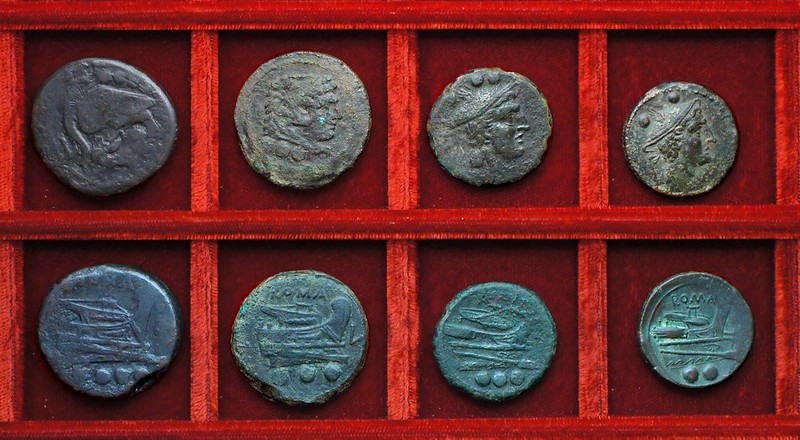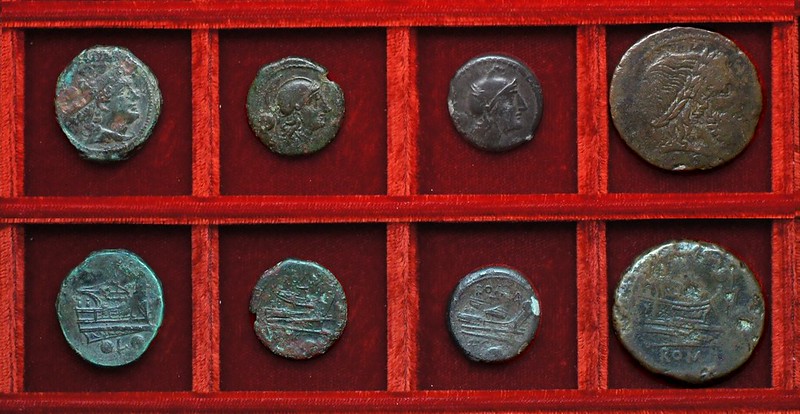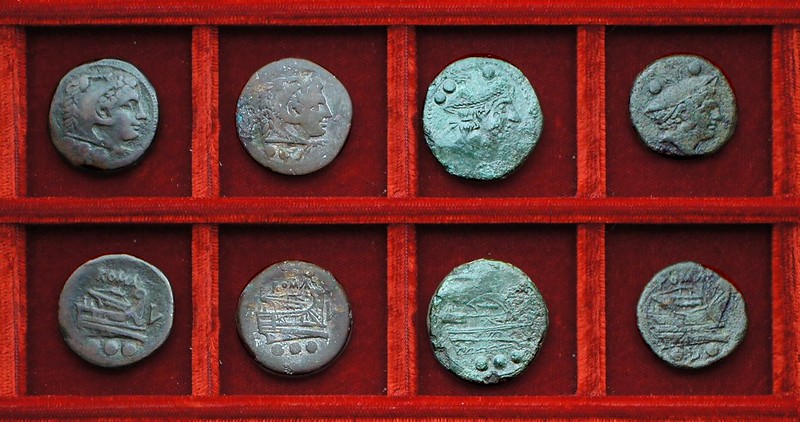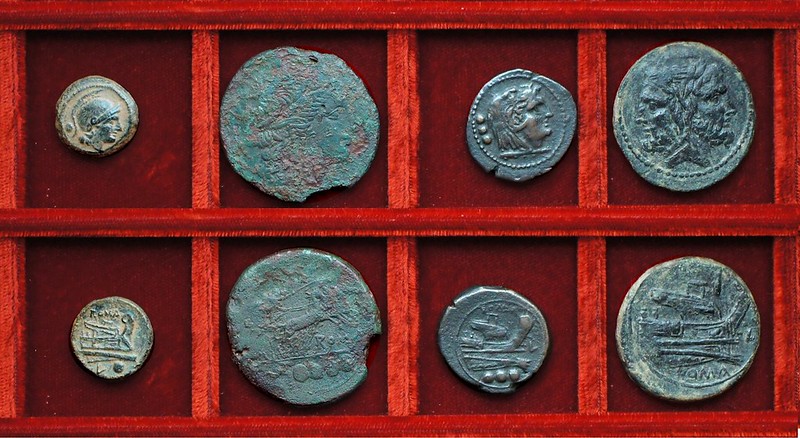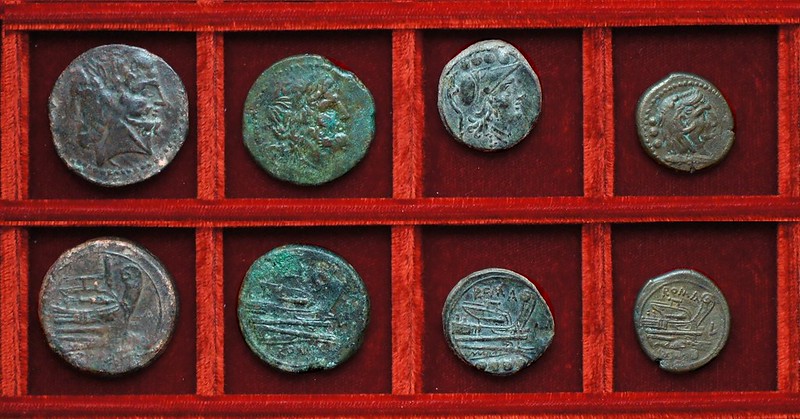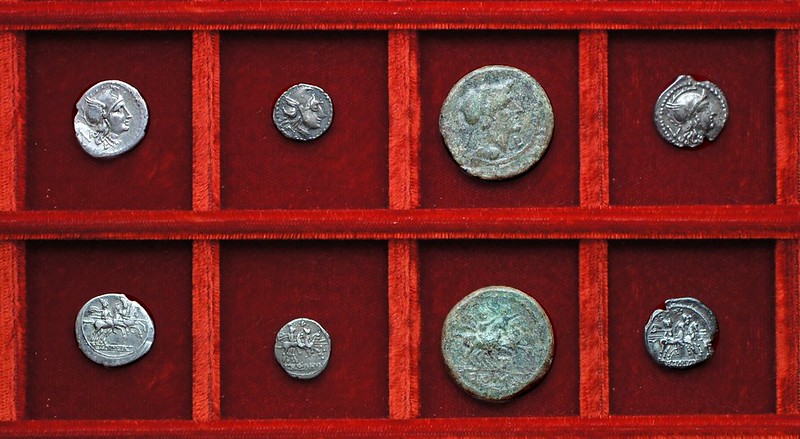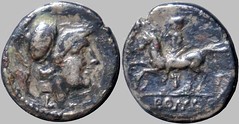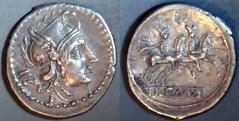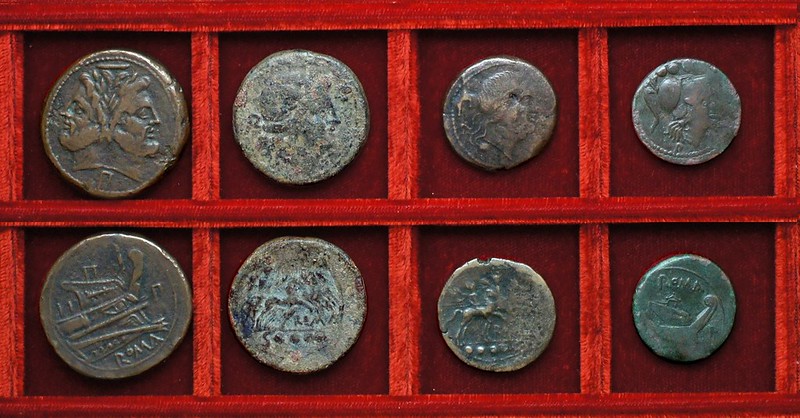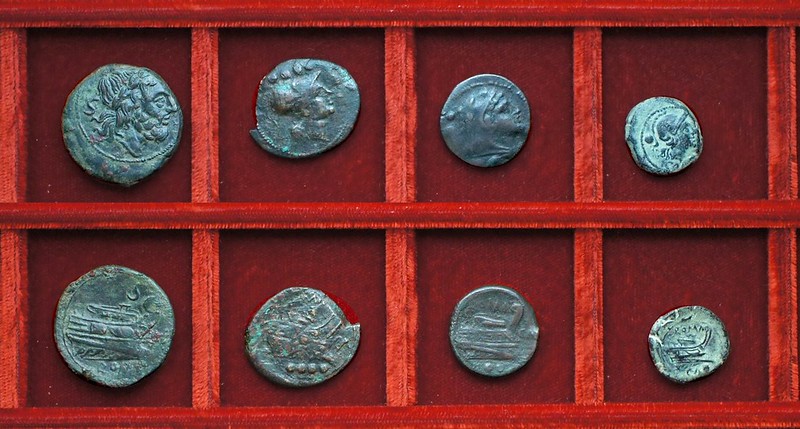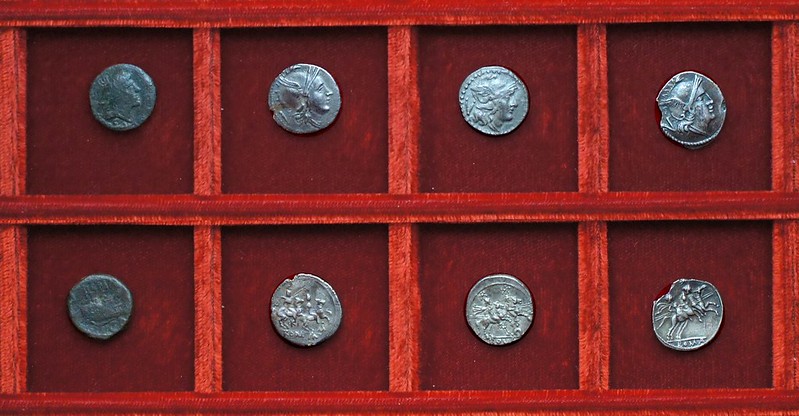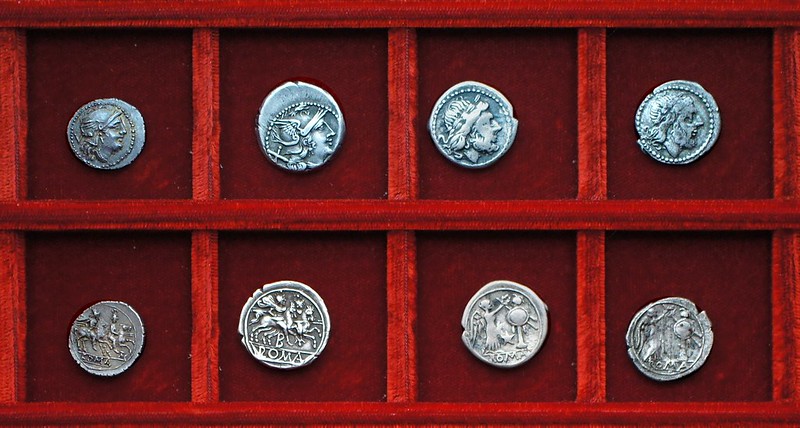Part 5 RRC 97 to RRC 111, 212BC to 207BC, First Denarius coinage Etruria, Luceria and related mints

|
Specialist Supplements:
1. Roman Coins of Luceria and Canusium
2. Anonymous Struck Bronze Coins of the Roman Republic
3. Anonymous Roman Republican Denarii and Victoriati (Steve Brinkman's site)
Principal Coins of the Roman Republic
Part 5 RRC 97 to RRC 111, 212BC to 207BC, First Denarius coinage Luceria and related mints, Etruria
RRC 97 Luceria L silver. Referring to the discussion under RRC 43 (Part 2 of this website) about the two Luceria mints, of Greek and Italic style, these silver types relate to the Greek-style issue.
RRC 97 Luceria L bronzes, RRC 97/4 triens, RRC 97/5a quadrans (both Greek-style), RRC 97/5c Mercury head quadrans, RRC 97/6a sextans (both Italic style). Because of the complexity of the Luceria series' I give the full Crawford RRC number for each type. An extended commentary can be found in my web-page on RRC 97 Luceria L.
The coins of Luceria and related issues with L, L-T, L-P, P and CA mintmarks deserve book length treatment, and I have worked with Roberto Russo on a monograph on the series. A difficulty with current catalogue arrangements is the lack of sufficient illustrated examples to give visual clues. From series 97, Crawford illustrates three bronzes from RRC 43 and thirteen from RRC 97, but these are chosen as much for their differences and uniqueness than for their typicality. The two Quadrantes RRC 97/13a pl.XVIII,8 and 97/13d pl.XVIII,8 are entirely different in obverse and reverse design, style and flan. The same goes for other apparently related coins e.g. 97/5b and 97/7a, or the Quincunx 97/11 and the Triens 97/12. Other than weight, what is to link these coins? The Triens RRC 43/3b with L under the chin has a broad and thin flan, quite unlike the illustrated RRC 43/3a. The cited RRC 43/3c in Hannover is similar in fabric and style to 43/3b, but without knowing this, a reader of RRC might reasonably assume it to look like the illustrated RRC 43/3a of compact style on a thick flan. However a coin that fitted such a visual description would actually be the also-unillustrated RRC 97/4. This is a difficult series!
Riccio's 1846 study recognised an arrangement by weight, style and fabric, although some if his illustrations show varieties which are not known to exist. d'Ailly gave a more systematic and accurate description of the corpus and provides ample data on weights as well as stylistically accurate line drawings. However he did not propose an arrangement or classification. Grueber in 'Essays Barclay Head' splits the coinage by weight into Triental, Sextantal and Uncial, but without the underlying data evidence provided by d'Ailly, and has nothing to add. Crawford's study of Luceria is the most comprehensive and is based around a careful study of the coins in the Paris collection, with the addition of missing examples from other collections. Paris contains 285 bronze coins of series L, L-T, P and CA and led him to propose a weight-based analysis into groups with As weights of 83 grams (RRC 43), 64 grams, 45 grams and 23.5 grams (all RRC 97) for series L, 22.5 grams for series P, and 27 grams for series CA. Although some new rare varieties have appeared since RRC's publication, the corpus in RRC is relatively complete and the broad classification by weight does actually reflect the coins in Paris. However the lack of visual evidence, and the known difficulty in preparing flans and striking bronzes to exact weights means that the RRC breakdown by weight is more a taxonomic convenience rather than reflecting mint organisation.
By examining a much larger corpus than that at Paris, Russo and I concluded that the L coinage can be broken into two mints or workshops, one which we describe as "Greek style", and the other as "Italic style" to which the RRC 98 LT and RRC 99 P coinage also belong. I repeat a little text from Part 2 of this website to make the distinctions clear. Quote "The Greek style coins all have obverse engraving styles in the best Hellenistic tradition, the faces have a beauty and nobility to them, and features such as the petasus - winged hat - of Mercury, and the lion-skin of Hercules, are engraved in classical style. The coins are all struck on relatively thick and short flans. The mintmarks are all prominent and clear, whether behind the head, before the prow or in the prow exergue. In contrast, the Italic style coins are struck on broad thin flans, and their engraving is sometimes rather crude, featuring large eyes and very large noses. The mintmarks are invariably small, visible with difficulty or not at all under the head or chin. The stylistic oddities continue through later much lighter coins. The Italic group also features odd denominations and designs that include the Dextans or Ten Uncia coin, the Quincunx or 5 Uncia coin, which represent the Nummus and Half-Nummus in use in many Italian cities." Unquote.
RRC 97 Luceria L bronzes, RRC 97/6b sextans (Greek style), RRC 97/7a uncia with Attic helmet, RRC 97/7b uncia with Phrygian helmet (both Italic), RRC 97/10 semis (Greek). Note that the two Italic style unciae are related by their obverse designs to the quinarius types of RRC 98 LT, which is an entirely Italic group, hence indicating the Italic coins come from the LT mint.
RRC 97 Luceria L bronzes, RRC 97/13a quadrans, RRC 97/13b quadrans (both Greek style), RRC 97/13d Mercury-head quadrans (Italic), RRC 97/14 sextans (Greek). Note that the 97/13d quadrans is on a wider thinner flan than the 97/13a and 97/13b pieces. CThe split between 97/5c and 97/13d Mercury head quadrantes is probably better based on the style and design differences (the location of the value mark) rather than on weight.
RRC 97 Luceria L bronzes, RRC 97/15 uncia (Greek style), RRC 97/16 dextans, RRC 97/20 quadrans, RRC 97/22a As with L before prow (Italic, as are all remaining coins). I believe the dextans to be the nummus or bronze unit of the Italic series. The Greek mint seems to have ceased production after RRC 97/10, RRC 97/13a,b, 97/14, 97/15, as their style and fabric do not occur on later coins. The As with L before prow is very much rarer than the common variety with L below prow.
RRC 97 Luceria L bronzes, RRC 97/22a As with no mintmark, RRC 97/24 semis, RRC 97/25 triens, RRC 97/26 quadrans. The illustrated As with no mintmark is part of McCabe anonymous bronze group F2.
RRC 97 L-P Luceria RRC 97/22b L-P Luceria As, with P mintmark below obverse head, L before prow, and Π mintmark above prow. This is the ANS example donated by Newell; other examples are in Naples and Hannover. The combination of P and L mintmarks on a single coin, with an obverse style typical of P, and a reverse that combines two mintmarks, L and Π proves the relation between the P and L mints.
RRC 97 Luceria L bronzes, RRC 98(A) LT Luceria silver. There are apparent mintmarks on the two Paris examples of the lightweight Asses RRC 97/28 and RRC 99/10 cited by Crawford (NB their photos were switched in the RRC plates), but no confirmed example with a clear mintmark has been seen.
RRC 98(A) LT Luceria silver and sextans, RRC 98(B) LT Luceria anonymous quinarius. The illustrated RRC 98A/4b is a very rare example of a mintmarked sestertius. The dioscuri type of the sextans is notable. As noted above, the quinarius types bear helmets that correspond to the unciae RRC 97/6a and RRC 97/6b.
RRC 98(A) LT Luceria silver, RRC 98A/2 Luceria LT Half Victoriatus. Paris BNF, courtesy Dominique Hollard and Michel Amandry. Another unusual reverse type. RRC 98A/4b sestertius, a different die engraver to compare with that in the red tray above.
RRC 99 P Luceria bronzes, RRC 99/1a As, RRC 99/2a dextans, RRC 99/4 quincunx, RRC 99/5 triens. Note the style match between the obverse of the As and that of the RRC 97/22b L-P As above.
RRC 99 P Luceria and RRC 100 CA Canusium bronzes, RRC 99/6 quadrans, RRC 100/1b CA As, RRC 100/1 variant As with no mintmark, McCabe group F3, RRC 100/2 variant semis with no mintmark and different style, McCabe group F2.
RRC 100 CA Canusium bronzes, RRC 100/2 semis, RRC 100/3 triens overstrike, RRC 100/4a quadrans, RRC 100/6b uncia. The semis often lacks an obverse mintmark but as the mintmark location is at the edge of the flan it is difficult to be sure whether it is present or not. There is a massive volume of overstrike Trientes, one of the commonest single types in the L, L-T, L-P, P and CA series. These overstrikes are over Oeniadae (Zeus right / river god Achelous right) and over the Acarnanian league, and are usually done in a very rough manner with understrike often visible. The undertypes were probably captured in the campaign of Marcus Valerius Laevinus in Illyria in 211 BC, which provides a termins post-quem for the types. There are many different of the CA mintmark and denomination marks on all denominations from As to Uncia, not all of which are documented in RRC. This series does not include a dextans or quincunx.
RRC 100 CA Canusium semuncia, RRC 101 KOR AG Corcyra quinarius, RRC 102 Q quinarii. The signed silver of Corcyra is unusual in having a spelled out mint-city name. The monogram ΑΓ may be that of a mint magistrate. The CA semuncia is a very rare mintmarked example of this small denomination.
RRC 103 MT quinarius, RRC 104 B denarius, RRC 105 pentagram victoriatus, RRC 106 staff victoriatus. The silver of these presumed Etruria issues is very complex, with many links between issues. There is an obverse die link between RRC 105 pentagram and RRC 106 staff victoriati. Anonymous denarii of the RRC 106 staff and RRC 107 C series cannot be separated. The relationship with the RRC 108 caduceus and RRC 109 curved knife types is unclear.
RRC 106 staff denarii, RRC 106 staff and club bronzes. The RRC 106 series from 'Etruria' is second only to Luceria in complexity for a mint-marked issue. Unlike Luceria whose many varieties are keenly sought after, the bronzes of RRC 106 are often mistaken for anonymous issues even when plainly mint-marked, and are invariably mistaken for anonymous issues when lacking a mint-mark. Even the RRC plates for the anonymous RRC 56 include some coins that should probably by sight be associated with RRC 106. These coins are usually associated with Etruria for mostly circumstantial reasons. Crawford says Etruria(?) without further comment. Yet the bulk of commentary does point towards Etruria, and none against, e.g. (a) Citta Ducala hoard - boundary of Latium and Etruria - where 7 of 15 bronzes with symbols were staff type and a further 70 noted as 'anonymous' may have included staff issues (b) metrological links between Mars/Eagle gold and late Etruscan gold, see Thomson ERC2, 295ff (c) RRC p.34 "I list the generals who received gold with tentative suggestions as to what they did with it ... M Marcellus in Etruria (500 lbs): part struck as issue with pentagram, part passed on to C. Calpurnius Piso [AM: promagistrate in Etruria 210 BC] and struck as issue with staff ..." (d) the distinctive style of these issues is reminiscent of the art and coins of Etruscan cities, the wild look with large staring eyes and straggly hair bringing to mind the Gorgoneion types (e) a further argument from silence comes from all other second punic fields of war and politics - Rome, Apulia, Sicily, Spain, Sardinia - having their clearly located coin issues. Etruria must have had a field coinage, which this must be.
RRC 106 staff and club bronzes. The descriptions of RRC 106/4 through 106/10 do not do justice to the sheer variety of staff and club varieties. The staff may either be above, as with the above triens and quadrans, or go through the deckhouse as in the semis on this tray, the club may be within the second wedge-shaped deckhouse or may be missing and/or present behind or under the obverse head as seen on the sextans in the following tray; the staff and/or club is sometimes missing on coins that are otherwise of the same design. The economical descriptions in RRC do not highlight how the staff is placed, or whether or how there is a reverse club present, or indeed all the obverse club varieties, for example with club under head. Hence, unlike with Luceria, I do not give piece-by-piece RRC numbers to this series. More important is to recognise the general style - the wide staring eyes, lined straggling hair, the wedged-shape deck house - and then to look carefully at each coin for evidence where the staff and/or club(s) may be hidden. Relative to their weight, most of these coins are struck on broad thin flans, some of the Semisses being so broad and thin, with weights above 25 grams at times, as to seem like an As. Given the large size of the issue there's a general question as to whether this coinage can all date from 209-208 BC, i.e. of the time of Marcellus and Piso in Etruria. The brockage semis, weighing 13.6 grams, is unusually heavy. A very interesting series that is undoubtedly not yet fully published.
RRC 106 staff and club bronzes, RRC 106 staff and club anonymous bronzes McCabe group E1. The sextans and uncia are, respectively, rare examples of an obverse-club type, and of a coin type which Crawford calls "unique", citing only the Capitoline example. The semis and triens are anonymous types, McCabe group E1, associated with the staff and club series. Crawford classifies this coinage under RRC 56, see pl.XI,10,12 for the Semis and Triens. When compared with RRC 106 Etruria coins it is difficult to accept they could be from anywhere else, given the closely matched obverse styles with wide staring eyes and similar facial features and hair styles. The heavy dotted border is another link, untypical of bronzes from other areas. But there are some specific differences that points to a different mint and/or a later issue. The reverse is different, always lacking the wedge-shaped deckhouse with club, and engraved with a less fine cutting tool which shows in the level of details. The flan shape is most unusual - distinctly concave on the reverse, somewhat convex on obverse and very thick, which points to a different location or timing. I am not aware of this flan shape on any other Roman coin, which must have been difficult to make because it required curved die shapes. It is possible that on all these coins the horizontal line to the left of the deckhouse is the staff of this series, though this cannot be stated confidently because such a line appears on many other bronze coin types. There is no difference in weight standards between this issue and the with-staff RRC 106 series, so this may be an issue from a separate Etruria mint in the same time period. Perhaps this was Marcellus' issue related to the pentagram silver, and that with staff was Piso's issue.
RRC 106 staff and club anonymous bronzes McCabe group E1, RRC 107 C denarii
RRC 108 caduceus denarius, RRC 111 AL Aelia denarius, Davis coll. RRC 108 seems related to the Etruria coins. I cannot place RRC 111, Crawford notes it as uncertain mint; it's style appears Sicilian to me.
RRC 109 curved knife denarius, RRC 110 wreath denarius. As with RRC 111, RRC 110 wreath has no clear home.
Specialist Supplements:
1. Roman Coins of Luceria and Canusium
2. Anonymous Struck Bronze Coins of the Roman Republic
3. Anonymous Roman Republican Denarii and Victoriati (Steve Brinkman's site)
All content copyright © 2004-2013 Andrew McCabe unless otherwise noted. If you've any questions or comments please contact me on the Yahoo Group RROME: http://groups.yahoo.com/group/RROME.
Alternately you can leave comments against any coin picture, just click on the picture and write in the comment box.
Site hosted free courtesy of VCoins.com
Ancient Coins on Vcoins
comment: this page is RRC097.html







